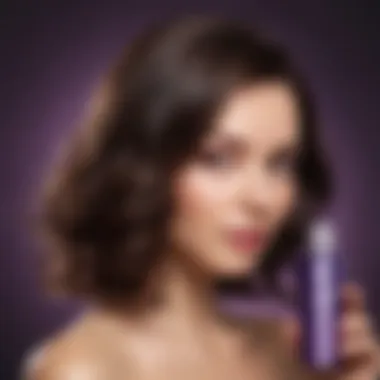Exploring Purple Shampoo's Effects on Brunette Hair


Intro
Purple shampoo has become a staple in many haircare routines, especially for those with brunette hair seeking to maintain their color. This product is formulated with purple pigments that help neutralize unwanted brassiness and warm tones that can develop over time. Understanding how purple shampoo works and its relevance can greatly impact how brunette hair is cared for.
Tips and How-Tos
Using purple shampoo effectively requires an understanding of your hair type and its current color status. Here are some key tips for brunettes:
- Frequency of Use: For best results, it is advised to use purple shampoo once a week or as needed. Overuse can lead to a purple tint in light brown or darker hair.
- Application Method: Apply purple shampoo to wet hair and lather thoroughly, focusing on areas that exhibit brassiness. Leave the shampoo in for about 3-5 minutes before rinsing.
- Follow-Up Conditioner: Using a conditioner that complements the purple shampoo is essential to retain moisture and maintain hair health.
- Dark Shade Considerations: Brunettes with dark shades may notice less impact from purple shampoo. It's important to assess the need based on personal experiences and results.
Skincare Routines for Different Skin Types
Though this article focuses on hair care, maintaining healthy skin can enhance overall beauty and personal care. Individuals with different skin types should consider tailored skincare routines that suit their unique needs. For example:
- Oily Skin: Look for products that are lightweight and oil-free.
- Dry Skin: Rich creams and moisturizers work well.
Sustainable Practices
Sustainability is growing in importance, even in hair care. Many brands are starting to offer eco-friendly products. When choosing hair care items, consider brands that prioritize sustainable sourcing and minimal packaging. Here are some practices to consider:
- Choose Eco-Friendly Products: Look for certifications like the Environmental Working Group (EWG) seal.
- Recycling: Always recycle your product containers if possible.
Celebrating Diversity in Beauty
The beauty industry is continually evolving, reflecting a diverse range of products and needs. Inclusive beauty brands are stepping up their game to cater to all hair types and tones, recognizing that beauty cannot be confined to one standard. Additionally, cultural influences on beauty trends can provide unique perspectives on hair care methods and products.
Preamble to Purple Shampoo
Understanding purple shampoo is crucial for achieving and maintaining the desired hair color, especially for those with brunette shades. This article aims to delve into specific elements of purple shampoo, highlighting its significance in hair care routines and its benefits for brunettes. As color maintenance becomes essential in the beauty industry, purple shampoo serves a distinct purpose that deserves closer examination.
Definition and Purpose
Purple shampoo is a specialized hair care product designed primarily to neutralize unwanted brassy or yellow undertones in hair. It functions through the principles of color theory, where purple, the opposite of yellow on the color wheel, helps in balancing tones in colored hair. For brunettes, purple shampoo offers several notable benefits. These include keeping brown shades looking vibrant and fresh while also enhancing shine. Unlike regular shampoos, purple shampoo often contains color pigments that specifically target unwanted hues, making it an essential part of many hair care routines. It is particularly favored by those who color their hair blonde or have highlights, but its use is increasingly recognized among brunettes as well.
Historical Context
The use of purple shampoo can be traced back to the hairdressing community as a response to the needs of clients with blonde hair. Over the years, as color trends evolved, so did the understanding of how hair color maintenance could enhance overall appearance. Initially, purple shampoos were created to serve lighter shades. However, with growing awareness and desire for versatile products, manufacturers began to formulate purple shampoos suitable for a variety of hair colors, including brunette shades. This evolution in formulation reflects a broader trend in beauty products adapting to diverse customer requirements.
Understanding these historical roots helps appreciate the position purple shampoo holds today, not just as a niche product but as a staple in many women’s hair care arsenals.
Purple shampoo has transitioned from a niche product for blondes to a vital part of brunette hair care routines.
Understanding Hair Color
Understanding hair color is crucial for comprehending how products like purple shampoo interact with different shades. Hair color is determined by the amount and type of melanin present in the hair strands. This factor significantly influences how hair responds to various treatments and products. For brunettes, color maintenance becomes particularly relevant because of the tendency for warm undertones to develop over time. Thus, the consideration of hair color in relation to treatment products ensures that users can advocate for healthier tresses.
Background on Brunette Shades
Brunette hair encompasses a vast spectrum from light brown to deep chocolate. Each shade carries unique characteristics and challenges. For example, lighter browns might appear brassy more quickly than darker shades due to their lower melanin content. It's essential for users to recognize that the natural undertones can have implications when using toning products.


Generally, brunettes can be categorized into three primary groups based on their shades:
- Light Brunette: Often contains warmer, golden undertones.
- Medium Brunette: Usually has neutral or slightly cool tones, balancing warmth and depth.
- Dark Brunette: Tends to have richer, cooler undertones, which can become emphasized during coloring processes.
Understanding these distinctions allows hair care enthusiasts to select the most suitable products. The right choice can lead to desirable color retention and enhancement of natural beauty.
Color Theory in Hair Care
Color theory plays an essential role in effective hair care, especially for brunette shades. It is based on the understanding of the color wheel, where complementary colors help to neutralize undesired tones. For instance, purple is directly across from yellow on the color wheel. This relationship is what makes purple shampoo so effective in counteracting brassy undertones in brunette hair.
When applied, purple shampoo can lead to a more vibrant and balanced appearance. Here are some considerations regarding color theory in hair care:
- Complementary Colors: Understanding how colors work together can help in selecting proper toning products.
- Hue and Depth: Different products can enhance or alter the depth and hue of hair color, directly connecting to the pigments used in hair dyes.
- Personalization: Individual hair characteristics affect how color theory applies, meaning customization of products is vital for optimal results.
Mechanisms of Purple Shampoo
Understanding the mechanisms of purple shampoo is essential for those interested in maintaining the vibrancy and richness of brunette hair. Purple shampoo primarily serves as a color-correcting treatment that can neutralize unwanted warmth. Knowing how it operates allows users to effectively incorporate it into their hair care routine. This section will break down the fundamental processes involved in purple shampoo's action and the active ingredients that contribute to its performance.
How Purple Shampoo Works
The central concept behind purple shampoo lies in color theory. Purple is opposite to yellow on the color wheel. Therefore, using a product that contains purple pigments can effectively counteract yellow undertones that may arise in brunette hair, especially those that have been lightened. This toning effect can enhance the overall depth and dimension of the hair color.
When applied to hair, purple shampoo deposits these violet pigments, which blend with the yellow tones, resulting in a more balanced and cooler shade of brown. The effectiveness of this process may vary based on hair type and the extent of previous coloring treatments. Thus, understanding individual hair characteristics is crucial for optimal results.
Active Ingredients
Active ingredients in purple shampoo play a significant role in its toning capabilities. Each ingredient interacts differently with hair, contributing to the efficacy of the product. Below are key components often found in these shampoos:
Sodium Lauryl Sulfate
Sodium Lauryl Sulfate (SLS) is a common surfactant used in many shampoos, including purple formulations. It functions as a cleansing agent, effectively removing dirt and oil from the hair.
- Key Characteristic: SLS creates a rich lather which enhances the feeling of cleanliness during shampooing.
- Benefit: Its effective cleaning power makess it a popular choice among users who desire thorough cleansing before the color correction process.
- Disadvantage: However, SLS can be harsh for some hair types. Frequent use may lead to dryness or irritation, particularly for individuals with color-treated or sensitive hair.
Color Pigments
Color pigments are the heart of purple shampoo. They are what predominantly provide the toning effect.
- Key Characteristic: These pigments are specifically formulated to counteract brassiness in hair color.
- Benefit: By integrating color pigments, the shampoo offers a subtle way to maintain rich tones in brunette hair, avoiding unnecessary warmth.
- Disadvantage: The results can vary depending on the user's hair qualities, and if used improperly, it might lead to an overly ashy appearance.
Silicones
Silicones are often included in purple shampoos for their ability to smooth and detangle hair.
- Key Characteristic: They coat the hair strands, enhancing shine and reducing frizz.
- Benefit: This can lead to healthier-looking hair, an important factor for users who want to maintain a polished appearance.
- Disadvantage: On the other hand, overuse of products containing silicones can result in build-up, making hair appear dull over time. Users must balance application frequency to prevent this issue.
Regular use of purple shampoo can dramatically enhance the aesthetic of brunette hair, but knowledge of its mechanisms and ingredients is crucial for achieving desired results without compromising hair health.
By now, readers should have a clearer understanding of how purple shampoo works and the ingredients that make it effective. In the following sections, we will explore its benefits for brunettes and considerations for its effective use.
Benefits for Brunettes


Understanding the benefits of purple shampoo for brunette hair is crucial for women seeking to maintain their color and enhance the vibrancy of their locks. Brunette hair can sometimes fade or develop unwanted tones over time, particularly under the influence of sun exposure or certain water conditions. Purple shampoo is formulated to counteract these issues, helping brunettes keep their hair looking radiant and healthy.
Toning and Neutralization
One of the primary functions of purple shampoo is its ability to tone and neutralize unwanted brassy shades. Brassy tones often appear due to oxidation, which occurs when the hair's natural pigments interact with environmental factors. When using purple shampoo, the purple pigments work to balance the warmth created by exposure to the sun or heat styling. This results in a cooler, more desirable hue. The application frequency will depend on individual hair conditions, but generally, using purple shampoo once or twice a week can help achieve the desired results without over-toning.
Benefits of toning brunettes include:
- Color correction: Diminishes unwanted orange or yellow undertones.
- Maintaining vibrancy: Helps keep brunette shades rich and lively.
Using it appropriately can ensure that the brunette color remains clear and free from dullness. Over time, users notice an improvement not only in color but in overall hair health. For those who invest in quality hair dye, using purple shampoo can protect that investment by enhancing its longevity.
Enhancing Color Depth
Beyond correcting unwanted tones, purple shampoo is an effective tool for enhancing the overall depth of brunette hair. When applied properly, it can make shades appear richer and more dimensional. The coolness of the purple pigments adds a subtle brightness without removing the foundational dark tones. This can be particularly appealing for those with medium to dark brown hair.
Incorporating purple shampoo into a regular hair care routine can lead to:
- Improved shine and luster: Brunettes often notice that their hair appears healthier and reflects light better.
- Enhanced richness: The overall brunette color may look more alive and three-dimensional.
In summary, understanding these benefits allows for informed choices regarding hair care routines. Women of various ages can appreciate the impact of the correct product application. As with any hair care product, results can vary depending on personal hair types and conditions.
"Purple shampoo is not just for blondes; it can be a game-changer for brunettes too."
With careful usage and understanding, purple shampoo can serve as a valuable addition to any brunette's hair care arsenal.
Considerations for Use
Frequency of Application
The frequency of applying purple shampoo is a critical element for achieving desired results. Too infrequent use may not provide the necessary toning effect, while excessive application can lead to unwanted changes in hair color. Generally, it is recommended to use purple shampoo once or twice a week for brunette hair, depending on the hair's initial tone and response. Some individuals may notice a need to adjust this based on personal preference and hair condition.
Additionally, factors like hair porosity and how often the hair is washed will influence this frequency. For instance, those with dry or damaged hair may consider using purple shampoo less frequently to prevent further drying out the strands. In contrast, those seeking more immediate results may opt to increase applications, aware of the risks involved.
Potential Risks
Over-Toning
Over-toning is a significant risk associated with the use of purple shampoo. This occurs when the product is applied too frequently, resulting in a buildup of purple pigment in the hair. It may lead to a bluish or grayish hue, which can detract from the natural beauty of brunette shades. While some individuals may appreciate the slight color shift, many find that it does not align with their desired outcome. The unique feature of over-toning is its immediate visual impact on hair color, yet the advantage here is a cautionary reminder of moderation. Balancing the frequency of use is essential to prevent this issue.
Color Stripping
Color stripping is another consideration that can arise with purple shampoo use. This can happen when the toning agents in the shampoo excessively lift color from the hair. The key characteristic of color stripping is its potential to leave hair looking uneven or overly processed. This aspect can be particularly troubling for individuals with highlighted or color-treated hair, as it may result in a less uniform appearance. However, color stripping can be seen as a warning signal about the potency of the product. Recognizing this risk is crucial for anyone using purple shampoo on brunette hair to avoid unintended results.
Compatibility with Hair Types
Compatibility with hair types is an essential factor when it comes to using purple shampoo. Brunette hair can vary widely in texture and thickness, affecting how the shampoo will perform. For example, fine hair may respond differently compared to thicker strands. Fine hair may require less frequent application to avoid overwhelming its delicate structure, whereas thicker hair might tolerate more consistent use without adverse effects.
Furthermore, the underlying condition of the hair plays a role. Damaged or chemically treated hair may not react positively to frequent use of purple shampoo due to its ingredients. Finding the right balance is important for maintaining overall hair health while also achieving the toning effects intended with purple shampoo.


In summary, being mindful of these considerations—application frequency, potential risks like over-toning and color stripping, and compatibility with hair types—can significantly impact how effectively purple shampoo enhances brunette hair. Each user's experience will vary, making it vital to approach usage with both curiosity and caution.
Common Misconceptions
Misconceptions about purple shampoo are common yet crucial to understand, especially for those with brunette hair. These myths can lead to improper use, which may affect hair color and health. It is important to clarify these misconceptions to enable informed choices in hair care routines.
Myths about Purple Shampoo
One prevalent myth is that purple shampoo is only beneficial for blondes. While purple shampoo was initially formulated to combat brassiness in blonde hair, its effects on brunette hair are noteworthy as well. Brunettes can also experience unwanted yellow or brassy tones due to environmental elements and daily wear. Misunderstanding the purpose of purple shampoo can result in reluctance to use it, even when it can help maintain rich, cool tones in brunette hair.
Another myth suggests that using purple shampoo will dramatically lighten brown hair. This is not true. Purple shampoo works to neutralize and tone brassiness rather than bleach hair. The intent is to enhance and maintain the existing color, not to shift the color drastically.
Furthermore, there is a belief that purple shampoo should be used every wash. This is inaccurate; overuse can lead to over-toning. The frequency should depend on the hair’s response and the degree of brassy tones. A careful approach can help avoid undesirable shades.
Clarification of Effects on Brunettes
For brunettes, purple shampoo serves distinct purposes. It enhances color vibrancy and combats unwanted warmth. The cooling effect of purple tones helps in maintaining a cooler hue, specifically for those with lighter brunette shades or highlights.
Brunettes might also find that using purple shampoo contributes to a richer appearance of their color. Regular use helps in prolonging the depth of their shade, minimizing the effects of external factors that tend to wash out color.
Alternatives to Purple Shampoo
Understanding alternatives to purple shampoo is essential for those with brunette hair who wish to maintain color vibrancy and avoid brassiness. While purple shampoo has its place, other products can complement or even replace its use, depending on individual needs and preferences. This section explores various alternatives that can effectively tone brunette hair, including specialized toning products and natural remedies.
Other Toning Products
Brunettes can consider several products besides purple shampoo for achieving a balanced hair tone. Here are some notable options:
- Toning Conditioners: These products work similarly to purple shampoo but are designed to be left on the hair longer for potentially more effective toning. Brands like Paul Mitchell and Redken offer toning conditioners that help to neutralize any unwanted warmth.
- Color-depositing Masks: These masks contain pigments that infuse color into the hair temporarily while also conditioning it. Popular brands include Olaplex and Aveda, which focus on nourishing hair while also providing color benefits.
- Purple Hair Treatment Products: There are specific treatments that combine the effects of toning and treatment. Products such as Fanola No Yellow Shampoo or Clairol Shimmer Lights balance out unwanted tones while caring for the hair’s health.
"For a balanced approach, consider using toning conditioners or masks alternating with purple shampoo. This can minimize any risk of over-toning and keep your hair looking vibrant."
These alternatives can provide flexibility in the hair care routine. Choosing among them can depend on color needs, hair type, and personal preferences. Additionally, it’s crucial to pay attention to the hair's response and adapt as necessary.
Natural Remedies for Toning
Natural remedies are also a viable route for those inclined to avoid synthetic ingredients. Several household items can assist in toning brunette hair. Here are a few:
- Chamomile Tea: Rinsing hair with brewed chamomile tea can subtly lighten and brighten brunette hair while removing brassiness. It is a long-term method requiring regular application.
- Apple Cider Vinegar: When diluted with water, apple cider vinegar can help balance the hair's pH and enhance shine. It also promotes healthy scalp conditions, which indirectley contributes to the overall hair appearance.
- Lemon Juice: This acidic solution can brighten hair, especially when used in combinations with sunlight exposure. However, care should be taken to not overuse, as it can lead to dryness.
Choosing natural products can be beneficial, as this method usually avoids harsh chemicals. However, results may differ based on hair texture and color. Some brunettes might find that combining natural remedies with other toning products yields the best results.
In summary, while purple shampoo is a valuable tool for many, various alternatives can provide effective toning and care for brunette hair. Toning conditioners, masks, and natural remedies offer diverse options for maintaining rich, vibrant color without becoming overly reliant on any single product.
Closure
Final Thoughts on Using Purple Shampoo
In summary, purple shampoo can offer significant benefits for brunettes. It helps to neutralize unwanted warm tones, thereby allowing the natural richness of brown shades to shine. However, it is crucial to approach it with knowledge and caution. Proper frequency and technique of application can lead to optimal results without damaging the hair.
"Color maintenance is not just about the product used but also how well it aligns with one’s hair needs."
To maximize the benefits, consider the following:
- Know Your Hair Type: Understanding whether you have fine, medium, or coarse hair can guide usage.
- Frequency: Regular use can be beneficial, but overuse may lead to dryness or unintended color effects.
- Complementary Products: Pairing purple shampoo with conditioners and treatments tailored for brunettes can enhance results.
The effectiveness of purple shampoo ultimately depends on informed choices and personal care routines. With the right approach, brunettes can enjoy stunning hair while minimizing potential downsides.







